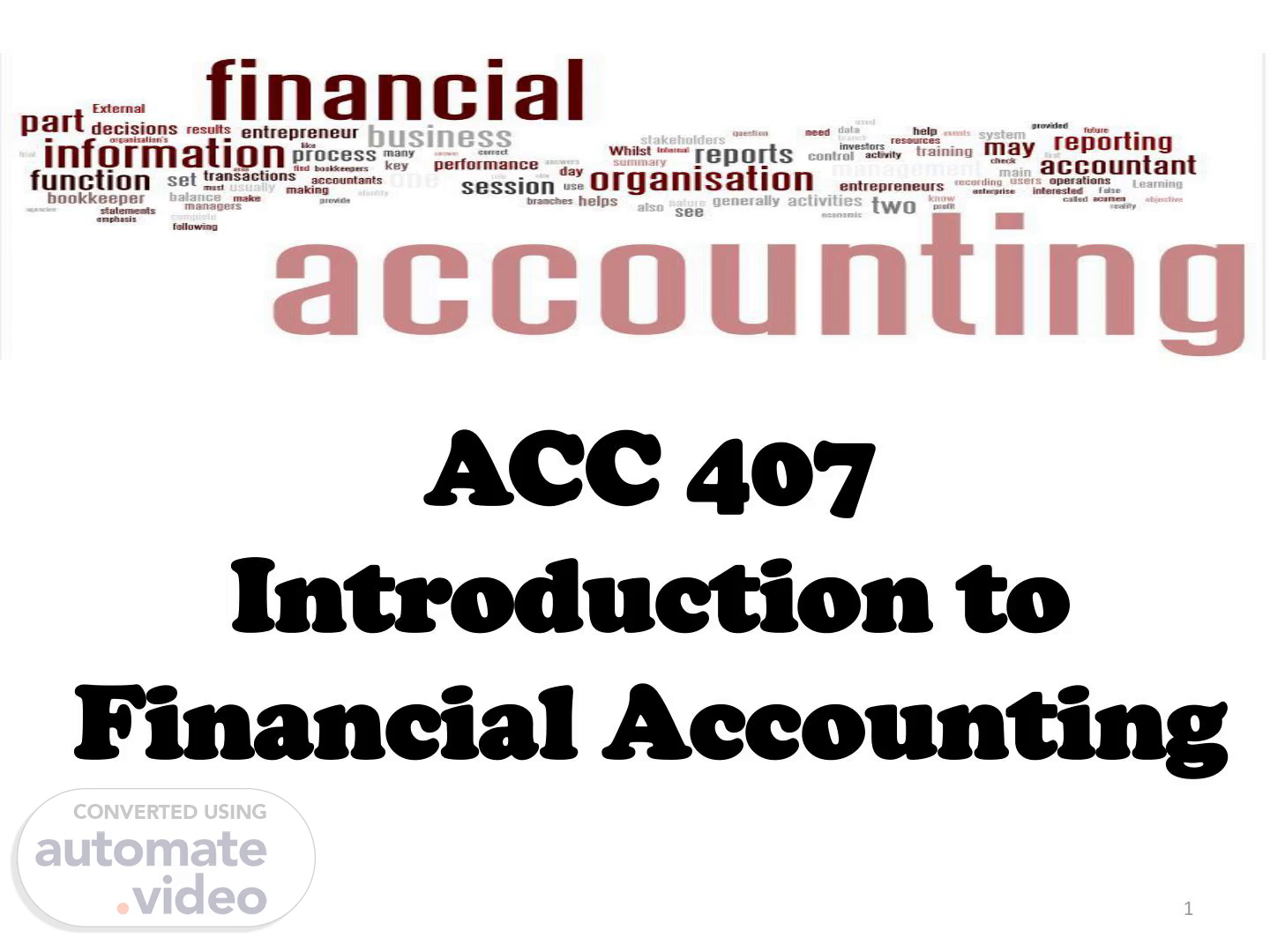
Acc 106 introduction to accounting
Scene 1 (0s)
[Audio] ACC 407 Introduction to Financial Accounting 1.
Scene 2 (7s)
[Audio] LEARNING OBJECTIVES At the end of this chapter, you should be able to: Explain difference terms and basic concepts of financial accounting Identify the users of accounting information Distinguish the different types of business organization Differentiate between bookkeeping and accounting 2.
Scene 3 (26s)
[Audio] INTRODUCTION Accounting is concerned with the provision of information which will be useful to those who are directly or indirectly connected with an organization The information provided would be useful both in assessing the performance of the managers and position of the organization 3 Business??? A business can be defined as an organization that provides goods and services to others who want or need them..
Scene 4 (50s)
[Audio] DEFINITION OF ACCOUNTING The process of classifying, recording and summarizing of transactions and business events in monetary terms, and interpreting the results to interested parties (users of financial statements) to assist them in decision making. Classifying Recording Summarizing Interpreting Accounting 4.
Scene 5 (1m 12s)
[Audio] PROCESS OF ACCOUNTING Sort out accounting data into orderly and meaningful categories. Example: Sales, Purchases, Debtors, Expenses Classifying Record the transactions in the books of business. Example: Record in journals and ledgers Recording Summarized accounting data in the financial statements. Example: Profit & Loss Account and Balance Sheet Summarising Analyze the financial statement and used the result of that analysis as guidance to make decision. Interpreting 5.
Scene 6 (1m 56s)
[Audio] As an evidence that the transactions have been taken place. To gather the accounting information (firm financial position) to prepare the financial report. To analyze and interpret the business transactions (based on financial report) to make decision. THE PURPOSES OF ACCOUNTING 6.
Scene 7 (2m 19s)
[Audio] THE USERS AND THE USE OF ACCOUNTING INFORMATION Interested to know the ability of the business to progress and expand. Employee Need information to guide them in planning, organizing and controlling the organizations and analyzing the operations of the business. Manager Interested in the profits earned from their investment and the financial stability of the business. Business owners INTERNAL USERS 7.
Scene 8 (2m 47s)
[Audio] Interested in the business accounting information for tax purposes. Government Interested in knowing the business solvency and financial strengths. Current/Potential Investors Interested to know whether the business can pay the amount owing to them. Creditor/Bankers THE USERS AND THE USE OF ACCOUNTING INFORMATION EXTERNAL USERS 8.
Scene 9 (3m 12s)
[Audio] TYPES OF BUSINESS ORGANIZATION Sole proprietorship Company (private limited & Public) Partnership 9.
Scene 10 (3m 21s)
[Audio] CHARACTERISTICS OF SOLE PROPRIETORSHIP, PARTNERSHIP AND COMPANY 1) OWNERSHIP Sole Proprietorship Partnership Company: Private Limited Company: Public ❖ Usually owned by single owner ❖ On his/her own name ❖ Normal: 2-20 partners ❖ Professionals: 2-10 partners ❖ Partners contribute capital and are the legal owners of the business ❖ 2-50 shareholders ❖Shares are offered to a certain group of people only and not opened to the public ❖ Shares are not listed in the share market ❖ 2 to unlimited number of shareholders ❖ The ownership is opened to the public through the selling of shares ❖ Shares are listed in the share market 10.
Scene 11 (4m 3s)
[Audio] 2) CAPITAL CONTRIBUTION Sole Proprietorship Partnership Company: Private Limited Company: Public ❖ Get the capital from personal savings, loans from relatives and friends, loans from financial institutions ❖ The size of capital is small ❖ Get the capital from contribution by the partners according to the percentage agreed. ❖ The size of capital is larger than sole proprietor ❖ Collected from the units of shares bought ❖The size is quite large ❖ Collected from the selling of shares to public ❖ The size of capital is large 11.
Scene 12 (4m 36s)
[Audio] 3) BUSINESS ESTABLISHMENT Sole Proprietorship Partnership Company: Private Limited Company: Public ❖ Easy to be established ❖Less regulations and restrictions ❖ There is an agreement of partnership which contains: Name of partners % of profit division Capital contribution Types of partners (Active, Sleeping, etc) ❖ register with ROB ❖ Register to SSM as required by CA 1965 ❖ Should put "Private Limited" (Sdn. Bhd.) at the end of the company's name ❖ Register to SSM as required by CA 1965 ❖ Should put "PublicLimited" (Bhd.) at the end of the company's name 12.
Scene 13 (5m 30s)
[Audio] 4) LIABILITY Sole Proprietorship Partnership Company: Private Limited Company: Public ❖ Unlimited liability ❖ If the business faced loss, it will involved personal assets if the business assets could not cover all the loss ❖ All debts and losses will be bear by partners ❖ Limited according to capital contribution ❖ Limited according to capital contribution 13.
Scene 14 (5m 54s)
[Audio] 5) EXAMPLES Sole Proprietorship Partnership Company: Private Limited Company: Public ❖ Kedai Runcit Pak Ali ❖ Usually in professional area, eg medical or law ❖Poliklinik Dr Azhar dan Rakan-Rakan ❖ Syarikat Amran Sdn. Bhd. ❖ Zuhairi Bhd ❖ Bank Islam Malaysia Bhd. 14.
Scene 15 (6m 21s)
[Audio] DIFFERENCE BETWEEN BOOKKEEPING AND ACCOUNTING Accounting is the process of classifying, recording and summarizing of transactions and business events in monetary terms, and interpreting the results to interested parties (users of financial statements) to assist in decision making while Bookkeeping is the mechanical aspects of accounting involving recording, classifying and summarizing business transactions Bookkeeping is only a part of accounting which concerned with the accurate recording of transactions. 15.